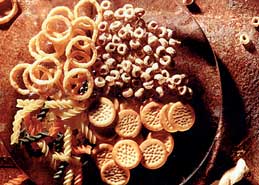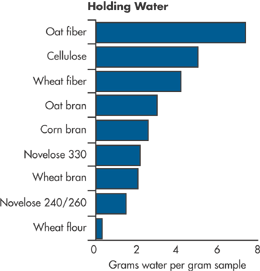
In the mid-1990s, National Starch and Chemical introduced Novelose® resistant starch, the first commercially available product to provide a concentrated source of resistant starch. Resistant starches are analyzed as total dietary fiber using AOAC methods 985.29 and 991.43. Resistant starches do not digest in the small intestine and are fermented in the large intestine by bacterial microflora. These specialty ingredients provide a source of dietary fiber without some of the formulation issues associated with whole grains.
For example, whole grains are very hydroscopic. Their use can create sticky dough that is hard to manipulate. Resistant starch has a propensity for water similar to flour, making it easier to incorporate into foods. Additionally, resistant starch—with a granular shape and a uniform particle size of 10-15 microns—performs well in baking applications. The consistency produces baked products with a uniform cell size and improved structure as compared to the dense structure in whole grain products. Their bland flavor allows higher usage levels and a wider range of applications.
Products formulated with resistant starch may carry a “Good Source of Fiber,” when formulated to deliver 2.5g of fiber per serving or “High Source of Fiber,” when formulated to deliver 5.0g of fiber per serving. Novelose resistant starches are derived from high amylose cornstarch. Novelose 240/260 can be labeled as “cornstarch.” Novelose 330 can be identified as “maltodextrin.”

Glycemic Response. Recent scientific evidence suggests that moderating blood sugar levels following food consumption (often called glycemic response) has benefits. They include reduced risk of developing diabetes, heart disease and other major diseases, as well as enhanced weight control through appetite control and sustained energy levels throughout the day.
A clinical trial tracked the average blood glucose level for 10 individuals over 120 min. after each consumed 50g of carbohydrate from a control bread or a test bread sample containing 20% dry basis resistant starch (Novelose 260). The test subjects had a Relative Glycemic Response of 55% as compared with 100% for those consuming the standard white bread control.
Colonic Health. Resistant starch and other dietary fibers are fermented by microflora in the large intestine, producing short-chain fatty acids (SCFA) as a product of fermentation. One of these SCFAs, butyrate, is a bio-marker for colonic health. Butyrate is preferentially used by the colonic mucosa as an energy source. In the clinical studies reported, resistant starch produced substantially more butyrate than other dietary fibers tested. Thus, resistant starch is a prebiotic fiber based on its preference to stimulate the bacteria that produce butyrate.
Lower Calories. Caloric control is paramount to combating obesity. Depending on the resistant starch product used, resistant starches contribute 1.6-2.5 kcal/gram vs. 4 kcal/gram for rapidly-digested starches.
For more information:
Call 1-800-797-4992
www.resistantstarch.com
National Starch Write in 403